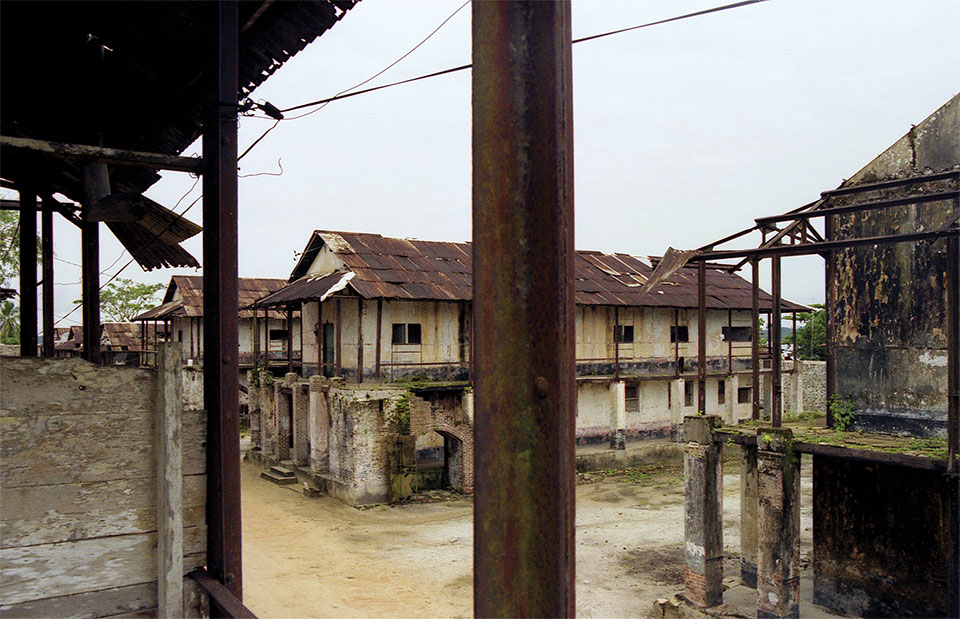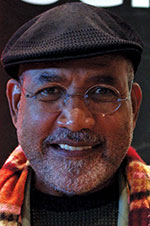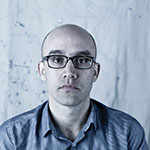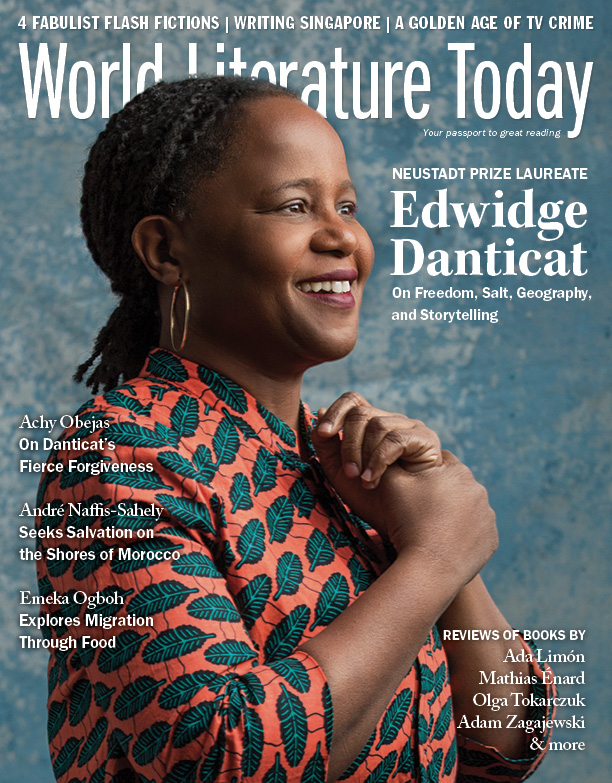Weaving a Creole Patrimony

In this excerpt from French Guiana: Memory-Traces of the Penal Colony, Chamoiseau explores the possibilities of rewriting the colonial legacy of one of the most notorious penitentiaries in the francophone world, which was established in 1852 and lasted till the mid-twentieth century.
To this lasting dream that keeps French Guiana in my heart. – Patrick Chamoiseau
Immobile in front of the parade, here are the memorial Stones that no marching order can touch or shake. They remain. – Victor Segalen
Our Monuments remain like suffering.
They bear witness to suffering.
They preserve suffering.
They are the common types of structures produced by the colonial trajectory: forts, churches, chapels, mills, jails, buildings concerned with the exploitation of sugarcane slavery, structures of military occupation. Statues and marble plaques celebrate explorers and conquistadores, governors and elite administrators. In French Guiana, like in the Antilles, these structures don’t inspire much affective response; if they bear witness to European colonials, they don’t bear witness to other populations (Amerindians, African slaves, Hindu immigrants, Syrian-Lebanese, Chinese) that were thrown onto colonial lands and, once there, had to find a way to survive, then to live together, and eventually to produce an original culture and identity.
The trajectory of these people was silenced. Not included in the colonial Chronicle, this trajectory came alive in its arts, its resistances, its heroisms, without stelai, without statues, without monuments, without documents.
The trajectory of these people was silenced. Not included in the colonial Chronicle, this trajectory came alive in its arts, its resistances, its heroisms, without stelai, without statues, without monuments, without documents. Only the word of the Elders that circulates beneath writing—oral memory—bears witness to it.
But a word isn’t a monument.
A word doesn’t make History.
A word doesn’t make Memory.
A word transmits histories.
A word diffuses memories.
A word bears witness in traces, in reminiscences, in protean anecdotes where the imagination intermixes with feeling.
And with emotion.
That is why we often say that in the Americas, monuments (and History with a capital “h”) bear witness to colonials, to the dominant power, to the colonial act with its genocides, enslavements, and assassinations of the Other. History, Memory, and the Monument magnify, or exalt (from the top of their supremacy), the crime that the colonial Chronicle legitimated.
The creole peoples of the Americas are tormented by their asphyxiating memories and their subterranean histories. When they turn to face the Monuments that define their spaces, they don’t find themselves there. In venerating these structures, they are expunged from Memory and from the History set down by colonization.
“Our landscape is its own monument: the trace that it signifies is detectable underneath. It’s the sum total of history,” wrote Édouard Glissant. This means that in the America of plantations (whether they be in French Guiana, on the edges of continents, or in the Antillean archipelago), in order to differentiate between the trajectories of the diverse peoples that are found there, it is necessary to reinvent the notion of the monument, to deconstruct the notion of patrimony. Beneath the texts of colonial History, it is necessary to find the trace of histories. Beneath the lofty Memory of forts and structures, it is necessary to find the few places where, for these collectivities, the decisive stages were crystallized.
In reading the Antillean landscape, Glissant detected in the highlands the path of runaway slave resistances to which no writing (in script or in monument) witnessed: his reading of the coastal plains and inhabited spaces permits us to find original witnesses to the capitulations and crafty revolts that the slaves and the immigrants devised in order to survive. His decoding of urban spaces allows us to follow (without pedestals and without statues) the slow progression of the former slaves toward the conquest of liberty. He marked out our Memorial sites, or more exactly the places of our Memory traces, whose symbolic, affective, and functional meanings, and whose known, evolving, and living significations, far outstrip the immobile purport of traditional monuments that we catalog in Western Memory.
❖
I sing memories against Memory. I, a creole American, sing histories against History.
I sing Memory traces against the Monument.
The Diverse opposes the Unique.
The open, the enclosed.
❖
WHAT IS A Memory trace?
It’s a space forgotten by History and by the Memory-One, because it bears witness to the histories of the dominated and demolished memories, and it helps preserve them.
The Memory trace cannot be made manifest by a monument, by stelai, by statues, or by the cult of the document of our former historians.
The Memory trace is a frisson of life whereas the monument is a dead crystallization. It is presence whereas the monument points elsewhere.
The Memory trace is at once collective and individual, vertical and horizontal, communitarian and cosmopolitan, unmovable and mobile, as well as fragile, whereas the monument always bears witness to the entrenched, vertical authority of the dominant power.
The meanings of the Memory trace are constantly evolving, with diffuse ramifications and inter-retro-reactions. The monument has only one single signification that most often fades in one or two generations.
The Memory trace is unseen.
The Memory trace might be material, for example the cliff from which the Caribs threw themselves en masse into the ocean to escape slavery. It might be symbolic, as in the mountain forests where runaway slaves took refuge or the silk-cotton tree. It might be functional, as in the coolie temple, or in the shack of old Negros, or in gros ka drums.
The gestures, the habits, the trades, the silent forms of knowledge, the corporeal forms of knowledge, the instinctive forms of knowledge, the symbols, the emblems, the words, the songs, the Creole language, the landscape, the old trees, the cooperative societies, the cane fields, the quarters—these are the Memory traces that we must now learn to recognize, to catalog, and to explore in the aim of patiently weaving together the open complexity of our creole patrimonies.
The penal colony of French Guiana is one such example.
❖
THE PENITENTIARY OF French Guiana is closely linked to the activity of clearing and planting the land as part of colonialism. This penitentiary activity produced these structures and buildings of exploitation (if it is possible here to risk putting it that way). These structures were places of imprisonment, security zones, forest camps, artisan workshops, hangars, forges, zoos, hospitals, and administrative offices. In the shared Imaginary, French Guiana’s land was viewed as a protective berm surrounding the prison. Up until 1946, and even after that, to say “French Guiana” meant no more than the “penal colony.”
The Guianese, refusing this equation, turned their backs on the remains of the penal colony, and even its very idea. As soon as the penitentiary activity ended, they attempted to forget these places, these walls, these holds, these grilles, these innumerable iron shackles, and these wharves.
They tried to consign the penal colony to oblivion.
The penitentiary architecture is visible beneath the relentless encroachment of the forest. Only the old penal workers have living memories, and their descendants, and their contemporaries. They recount, to anyone willing to listen, extraordinary stories that I was able to hear for myself at the end of a long chain of echoes. Well, I didn’t hear the half of it, but the little that was offered to me reminded me that there was in that location one of the most poignant divagations of humanity.
One of the most repugnant as well.

❖
IN DELVING INTO the stories of the penal colony, I found all the heroism, all the dignity, all the fervor, but also all the inhumanity, the aggressive denials, the height of suffering and indignity, the pinnacle of courage and weakness, a mind-boggling concentration of everything that makes up humanity: explosions of shadows and light, of light in shadows, and shadows lightening. All this is dispersed in the Guianese Memory, pushed to the furthest, dimmest corners of the Guianese mind.
But forgetting sometimes makes you remember.
There wasn’t a single penal worker who didn’t give a little of his life, his suffering, his blood, his rage for survival, and his talent for this country.
Forgetting makes you remember because of the rigor of the act of forgetting. And forgetting returns to remembering in another manner: French Guiana forgot the penal colony to remember it better. Because the penal colony was located at the living heart of French Guiana in the same forgotten story of slavery, Amerindian revolt, runaway slaves, gold fever and prospectors, and Chinese settlers. The routes, the paths, the railroads, the land reclamation projects, the construction of buildings, canals, dikes, the connection of villages, the administrative and commercial activity, and the memory of the arts—there wasn’t a single space that didn’t profit from the industry of the penal worker. There wasn’t a single penal worker who didn’t give a little of his life, his suffering, his blood, his rage for survival, and his talent for this country.
French Guiana was born from these silent miseries and from these subterranean memories as well. All these memories are a part of the country. If even one memory should be missing from the inventories of meaning, then French Guiana wouldn’t know how to know itself.
❖
WHO COULD HAVE DARED think like this a century ago?
The penitentiary structures of horror, worn down by the years, polished by time, are transformed not into monuments but into Memory traces. And these vestiges, even though essentially colonial, present the paradox of not bearing witness to colonial domination but to those beneath it who tried to draw in more breaths more full of oxygen—I mean, more humanity.
These remains bear witness to a human tragedy: they make Traces.
❖
THE STRUCTURES OF organized death make Memory traces because they arise from death. They return to death the opacity that evokes feeling, that is to say, emotions and flashes of sensations.
They make Memory traces because for many years they were abandoned to a solitary confrontation with vegetal fury, coiling roots, and suffocating branches. The walls had to fight with the tortured tree life rising from their hearts; tree stumps unearthed enormous rocks one by one. Rain, insects, and humidity petrified the wood, wore down iron, stone, grilles, and broke into holds and buildings. People came, rampaged, pillaged, and lived in the desolation.
It could never be wholly effaced.
But the memory of the men who had been there, who had suffered there, was mysteriously still alive. From the wear and tear of this confrontation were borne the most stunning of human patrimonies: the Memory traces of the penal colony of French Guiana.
❖
THE MEMORY TRACES of the penal colony are broken, diffused, scattered. You can’t approach them in the same manner that you do the façade of a Cistercian abbey or a Roman church. I can’t, and I don’t wish to, give you the official tour, or render for you the spaces and walls in well-planned words. I can’t, and I don’t wish to, wax eloquently on the balance of height and weight and other architectural features. It’s a strictly Western naïveté to think that something lost to time can be elucidated in descriptions of volume, mass, and surface. The monument is indescribable, and it can be imagined only in the exact alchemical moment when it emerges from behind its material conditions. The Memory trace is yet more indescribable because it offers little by way of volume and mass. To go there isn’t to do something. It’s to live as a medium to the beyond.
❖
THE MEMORY TRACES of the penal colony begin along the ocean, from Cayenne to St. Laurent, passing through Kourou. Beginning in 1852, numerous attempts were made to establish camps after the decision to transport to the colonies all French prisoners condemned to forced labor. Each time malarial fever wiped out the convicts and their warders. The first camps to find a reprieve were in the breezy islands where the insects and their fever seemed less virulent. What the Amerindians called the Islands of the Devil had become very quickly Salvation’s Islands where it was possible to survive.
These three islands off the coast of Kourou (Île Royale, Devil’s Island, St. Joseph Island) were the epicenter of the first penitentiary activity in French Guiana. It’s from there that governor upon governor, with the dead piling up by the hundreds, set out to establish new camps, new settlements—to overcome obstacles, to attempt audacious new locations very quickly abandoned. They drew inland, along the rivers, to the place at the mouth of the Maroni River that would take the name St. Laurent. This is where the penal colony found its center. From there, the forest camps would be established, the artisanal activity, the agricultural work, everything. It was there where the most complete structures were built. It was there where the administration of death set down its rules.
❖
BUT THE MEMORY TRACES of today don’t only bear witness to the history of the penal colony—a fascinating and terrible history. One can find that in dozens of books, chronicles, witness accounts, and celebrated articles. It’s better to abjure history writing on the penal colony; then we can discern what the Memory traces murmur to us.
They don’t speak only of the penal colony. Through time, they have become charged with countless memories. Through long, mossy sighs, they link the penal colony to the forest life that now seems to encase them. The structure becomes a ruin, and by a spontaneous movement resulting from an invisible accumulation, the ruin becomes open memories.
Translation from the French
Editorial note: From Guyane: traces-mémoires du bagne (1994), by Patrick Chamoiseau, with photographs by Rodolphe Hammadi. Forthcoming as French Guiana: Memory-Traces of the Penal Colony from Wesleyan University Press in fall 2019.












